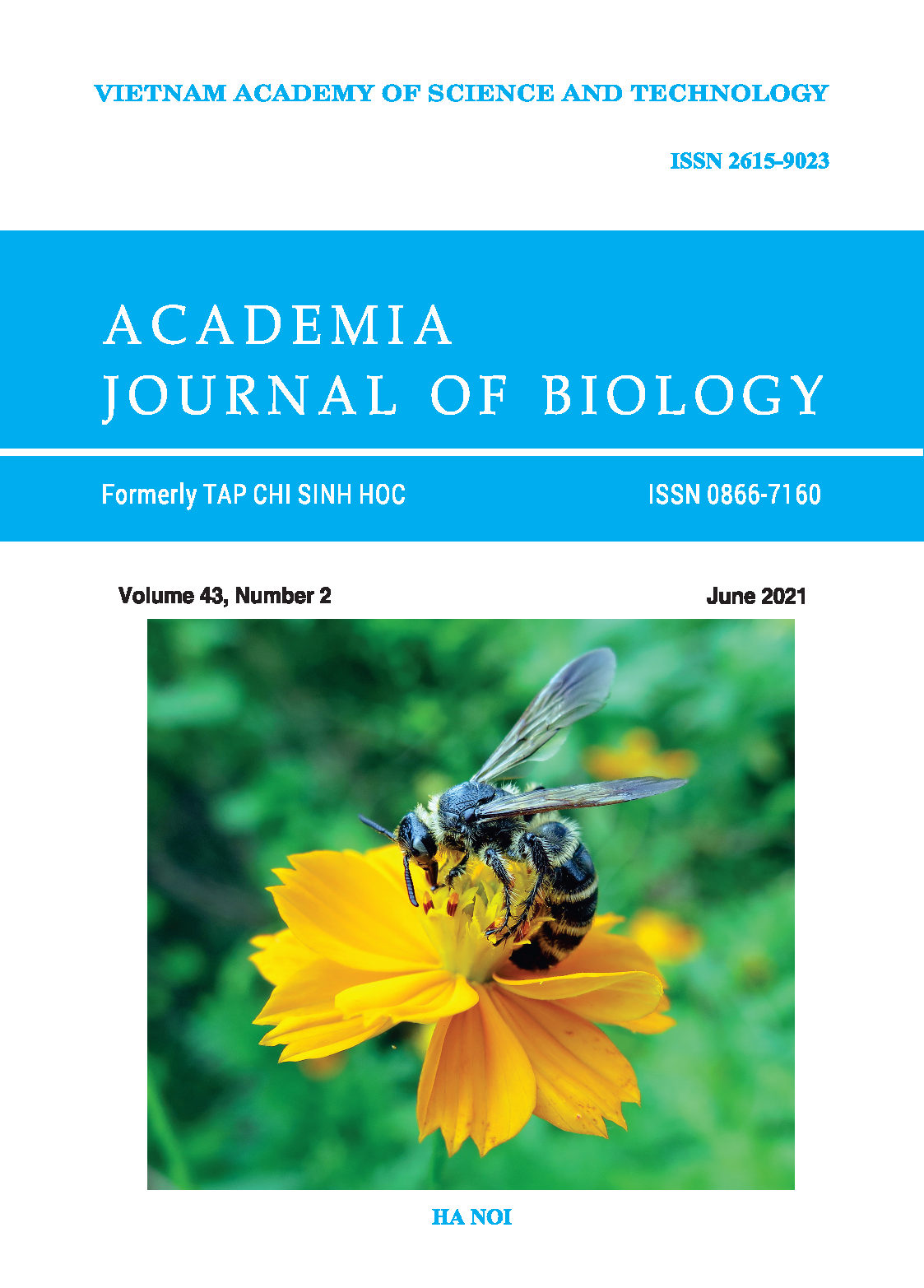Chemical composition and antimicrobial activity of essential oils from \(\textit{Angelica sinensis}\) (Oliv.) diels cultivated in Hung Yen province of Vietnam
Author affiliations
DOI:
https://doi.org/10.15625/2615-9023/15634Keywords:
Angelica sinensis, essential oil composition, antimicrobial activityAbstract
Essential oils from roots, flowers, fruits, and leaves plus stems of Angelica sinensis cultivated in Vietnam were obtained by hydrodistillation and were analyzed using GC/MS-FID. In total, 36, 30, 33, and 27 compounds were found accounting for 98.7%, 98.8%, 99.2%, and 100% of the oils compositions, respectively. (Z)-Ligustilide (49.4%, 29.6%, 25.8%, 28.9%) and γ-terpinene (20.6%, 38.5%, 35.5%, 44.2%) were the main components of the respective essential oils. Especially, dictyopterene C (10.8%) was found to be one of the main components of fruit oil. Among the A. sinensis essential oil samples tested, the fruit oil revealed the strongest antimicrobial activity against bacteria Escherichia coli and yeast Candida albicans with median inhibitory concentration values of 0.97 and 0.15 mg/mL, respectively.
Downloads
References
Adams R. P., 2001. Identification of essential oil components by gas chromatography, quadrupole mass spectroscopy. Carol Stream, Ill.: Allured Publishing Corporation; 3rd edition. ISBN: 0931710855, pp. 456.
Champakaew D., Junkum A., Chaithong U., Jitpakdi A., Riyong D., Sanghong R., Intirach J., Muangmoon R., Chansang A., Tuetun B., Pitasawat B., 2015. Angelica sinensis (Umbelliferae) with proven repellent properties against Aedes aegypti, the primary dengue fever vector in Thailand. Parasitology Research, 114: 2187–2198.
Chao W. W. and Lin B. F., 2011. Bioactivities of major constituents isolated from Angelica sinensis (Danggui). Chinese Medicine, 6: 29.
Chen S. W., Min L., Li W. J., Kong W. X., Li J. F., Zhang Y. J., 2004. The effects of Angelica essential oil in three murine tests of anxiety. Pharmacology Biochemistry and Behavior, 79: 377–382.
Cos P., Vlietinck A. J., Berghe D. V., Maes L., 2006. Anti-infective potential of nature products: How to develop a stronger in vitro ‘proof-of-concept’. Journal of Ethnopharmacology, 106(3): 290–302.
Do H. B., Dang Q. C., Bui X. C., Nguyen T. D., Do T. D., Pham V. H., Vu N. L., Pham D. M., Pham K. M., Doan T. N., Nguyen T., Tran T., 2004. Medicinal plants and animals in Vietnam. Vol. 1. Science and Technolgy Publishing House, pp.1138 (in Vietnamese).
Hadacek F., Greger H., 2000. Testing of antifungal natural products methodologies, comparability of result and assay choice. Phytochemical Analysis, 11: 137–147.
König W. A., Joulain D., Hochmuth D. H., 2019. Terpenoids library - Terpenoids and related constituents of essential oils. https://massfinder.com/wiki/Terpenoids_Library (accessed: April 12, 2020)
Kuang X., Du J. R., Liu Y. X., Zhang G. Y., Peng H. Y., 2008. Postischemic administration of Z-Ligustilide ameliorates cognitive dysfunction and brain damage induced by permanent forebrain ischemia in rats. Pharmacology Biochemistry and Behavior, 88(3): 213–221. https://doi.org/10.1016/j.pbb.2007.08.006
Li J., Hua Y., Ji P., Yao W., Zhao H., Zhong L., Wei Y., 2016. Effects of volatile oils of Angelica sinensis on an acute inflammation rat model. Pharmaceutical Biology, 54: 1881–1890.
Li S. Y., Yu Y., Li S. P., 2007. Identification of antioxidants in essential oil of radix Angelicae sinensis using HPLC coupled with DAD-MS and ABTS-based assay. Journal of Agricultural and Food Chemistry, 55: 3358−3362.
Linstrom P. J. and Mallard W. G., 2020. NIST chemistry webbook, NIST standard reference database number 69, National Institute of Standards and Technology, Gaithersburg M. D., 20899, https://doi.org/10.18434/T4D303 (accessed: April 12, 2020)
Liu L. S., Peng C., Zhou Q. M., Xiong L., Guo L., Wang Y. N. and Dai O., 2017. Effects of angelica oil and the isolated butylphthalides on glutamate-induced neurotoxicity in PC12 cells. Records of Natural Products, 11(2): 217–222.
Ministry of Health, 2009. Vietnam Pharmacopoeia IV. Medical Publishing House, Hanoi, Vietnam., pp. 962 (in Vietnamese).
Mullen K. A., Lee A. R., Lyman R. L., Mason S. E., Washburn S. P., Anderson K. L., 2014. Short communication: An in vitro assessment of the antibacterial activity of plant-derived oils. Journal of Dairy Science, 97: 5587–5591.
Nguyen X. D., Luu D. C., La D. M. & Leclercq P. A., 1996. Composition of the leaf and flower oils from Angelica sinensis (Oliv.) Diels cultivated in Vietnam. Journal of Essential Oil Research, 8(5): 503–506.
Peng H. Y., Du J. R., Zhang G. Y., Kuang X., Liu Y. X., Qian Z. M., and Wang C. Y., 2007. Neuroprotective effect of Z-ligustilide against permanent focal ischemic damage in rats. Biological and Pharmaceutical Bulletin, 30(2): 309–312.
Tabanca N., Wedge D. E., Wang X., Demirci B., Baser K. H. C., Zhou L. and Cutler S. J., 2008. Chemical composition and antifungal activity of Angelica sinensis essential oil against three Colletotrichum species. Natural Product Communications, 3(7): 1073–1078.
Vo V. C., 2012. Vietnamese medicinal plant dictionary. Vol. 1. Medical Publishing House.
Wedge D. E., Klun J. A., Tabanca N., Demirci B., Ozek T., Baser K. H. C., Liu Z., Zhang S., Cantrell C. L., Zhang J., 2009. Bioactivity-guided fractionation and GC/MS fingerprinting of Angelica sinensis and Angelica archangelica root components for antifungal and mosquito deterrent activity. Journal of Agricultural and Food Chemistry, 57: 464–470.
Wedge D. E., Tabanca N., Demirci B., Ozek T., Baser K. H. C., Klun J. A., Liu Z., Zhang S., Cantrell C. L., Zhang J. K., 2008. GC-MS fingerprinting of Angelica sinensis and A. archangelica root components and mosquito deterrent activity. Planta Medica, 74(03): 361–361.
Yao W., Zhang L., Hua Y., Ji P., Li P., Li J., Zhong L., Zhao H., Wei Y., 2015. The investigation of anti-inflammatory activity of volatile oil of Angelica sinensis by plasma metabolomics approach. International Immunopharmacology, 29: 269–277.
Downloads
Published
How to Cite
Issue
Section
License
Academia Journal of Biology (AJB) is an open-access and peer-reviewed journal. The articles published in the AJB are licensed under a Creative Commons Attribution-NonCommercial-NoDerivatives 4.0 International License (CC BY-NC-ND 4.0), which permits for immediate free access to the articles to read, download, copy, non-commercial use, distribution and reproduction in any medium, provided the work is properly cited (with a link to the formal publication through the relevant DOI), and without subscription charges or registration barriers. The full details of the CC BY-NC-ND 4.0 License are available at https://creativecommons.org/licenses/by-nc-nd/4.0/.












